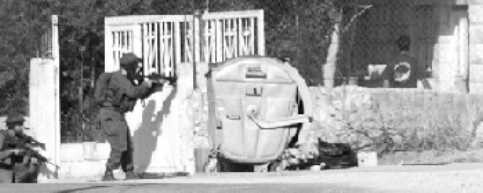13 May 2003
During a Border Police operation in Jenin today, Border Police Officers shot and hit a car with five passengers, including a woman, her daughter and seventeen-month-old grandson. They then forced the driver to park the car in front of Khalil Musbah’s home and used it as a shield during a gun battle with armed Palestinians.

Archive Photo: Israeli forces use a Palestinian civilian as a human shield (Photo: Jihad Nga, B’Tselem)
The two women and baby were inside the car. In the course of the battle, a Border Police officer who was standing behind Muhamad ‘Aradeh (one of the passengers) fired over his head, using him as a human shield. B’Tselem is also investigating preliminary details regarding the use of Khalil Musbah’s relatives as human shields.
The testimony was given to Najib Abu Rokaya by telephone on 14 May 2003
“I live in Arraba, a village near Jenin. Today [14 May 2003], I went with my cousin Ahmad ‘Arrada to the Jenin refugee camp to pick up his mother, sister, and his sister’s eighteen-month-old son. They had been visiting Ahmad’s married sister, who lives in the camp. We then started back to Arraba.
When we reached the eastern exit of the camp, I saw three armed individuals who were dressed in civilian clothes and had masks on. I thought they were young Palestinians. They fired at our car. One bullet hit the front windshield and penetrated into the car. Miraculously, nobody was injured.
Ahmad stopped the car. I got out with my hands raised. We were about ten meters from the armed men. Alongside them were Israeli soldiers in uniform. I then realized that the individuals in civilian clothes were Israeli soldiers. Two or three of the Israelis who were wearing civilian clothing approached us. They led Ahmad and me to a house which was surrounded by many soldiers. The two women and the baby stayed in the car. The soldiers ordered Ahmad to park the car opposite the entrance to the house. When he came back, the soldiers ordered him and me to kneel in front of the entrance to the house and covered our eyes with pieces of cloth.
At the same time, I heard gunfire, which I think was aimed at the Israeli soldiers. I couldn’t see who was shooting and where they were shooting from. I heard the soldiers shooting back. One of them told me to kneel. He knelt behind me and shot two or three bullets over my head. Then he took me to another place. I later realized that he had taken me behind a wall that surrounds the house. The soldier again kneeled behind me, but he did not fire.
All this time, the soldiers continued shooting. I think that they also fired machine guns because the gunfire sounded more intense. The soldiers were continually calling to the people in the house to come outside. I heard people shouting, and the soldiers asking them what their names were.
The incident continued for about two hours. It began around 2:30 - 2:45 P.M. and ended around 4:30. During this two-hour period, the soldiers moved me from place to place.
At some stage, one of the soldiers removed my blindfold and ordered me to go into the house. He pointed out a door of a room inside the house and told me in Arabic to go into the room and remove the small children from the house. I told him that I did not know the people in the house, and that I did not consent to go inside. Then a Palestinian journalist named Sausan came over to us. He said to the soldier, “I will go inside.” A woman foreigner was with the journalist. The soldier shouted at her to lie down on the ground.
Then the soldier pushed me over to the wall surrounding the house and had me stand there. Another soldier blindfolded me once again.
When the soldiers finished, they gave me back the car keys and told me to leave with the two women and the infant, who had remained in the car all this time. Ahmad was detained with some other individuals. I drove them to the hospital in Jenin.”
“While the shooting was going on, my daughter, Nihad, her seventeen-month-old son ‘Izz a-Din and I were in the car. The Palestinians and the Israelis were shooting and some Palestinian youths were throwing stones at the soldiers. The stones hit the car. My daughter and I were crying all the time. I was really scared that the baby or my daughter or I would be hurt. We recited verses from the Koran and prayed for our safety and the well-being of the others.”
Use of Human Shields – Background:
On 5 May 2002, seven human rights organizations, including B’Tselem, petitioned the High Court of Justice against the IDF’s use of Palestinian civilians as human shields. The petition presented a long list of cases illustrating this policy.
Two days after the petition was filed, the state informed the High Court that, “…the IDF has decided to issue immediately an unequivocal order to the forces in the field. The order states that forces in the field are absolutely forbidden to use any civilians as a means of ‘living shield’ against gunfire or attacks by the Palestinian side.” Two weeks ago, the petitioners filed a detailed list of additional cases in which Israeli security forces have recently used “human shields.
Related Links: